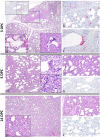This is a preprint.
Pathogenicity and transmissibility of bovine-derived HPAI H5N1 B3.13 virus in pigs
- PMID: 40093138
- PMCID: PMC11908241
- DOI: 10.1101/2025.03.04.641414
Pathogenicity and transmissibility of bovine-derived HPAI H5N1 B3.13 virus in pigs
Update in
-
Pathogenicity and transmissibility of bovine-derived HPAI H5N1 B3.13 virus in pigs.Emerg Microbes Infect. 2025 Dec;14(1):2509742. doi: 10.1080/22221751.2025.2509742. Epub 2025 Jun 16. Emerg Microbes Infect. 2025. PMID: 40396285 Free PMC article.
Abstract
Since the first emergence of highly pathogenic avian influenza (HPAI) H5N1 viruses in dairy cattle, the virus has continued to spread, reaching 17 states and at least 970 dairy herds in the United States. Subsequently, spillovers of the virus from dairy cattle to humans have been reported. Pigs are an important reservoir in influenza ecology because they serve as a mixing vessel in which novel reassortant viruses with pandemic potential can be generated. Here, we show that oro-respiratory infection of pigs resulted in productive replication of a bovine-derived HPAI H5N1 B3.13 virus. Infectious virus was mainly identified in the lower respiratory tract of principal infected pigs, and sero-conversion was observed in most of the principal pigs at later time points. In one animal, we detected the emergence of a mutation in hemagglutinin (HA) previously associated with increased affinity for "mammalian-type" α2,6-linked sialic acid receptors, but this mutation did not reach consensus levels. Sentinel contact pigs remained sero-negative throughout the study, indicating lack of transmission. The results support that pigs are susceptible to a bovine-derived HPAI H5N1 B3.13 virus, but this virus did not replicate as robustly in pigs as mink-derived HPAI H5N1 and swine-adapted influenza viruses.
Keywords: cattle; genotype B3.13; highly pathogenic avian influenza; mammalian-adapting mutation; pathogenicity; pig; transmissibility.
Conflict of interest statement
Declaration of interest statement The J.A.R. laboratory received support from Tonix Pharmaceuticals, Xing Technologies, Esperovax, and Zoetis, outside of the reported work. J.A.R. is inventor on patents and patent applications on the use of antivirals and vaccines for the treatment and prevention of virus infections, owned by Kansas State University.
Figures





References
-
- World Health Organization. Cumulative number of confirmed human cases for avian influenza A(H5N1) reported to WHO, 2003–2023, 5 January 2023. 2023.
-
- World Health Organization. Evolution of the influenza A(H5) haemagglutinin: WHO/OIE/FAO H5 Working Group reports a new clade designated 2.3.4.4 2015. Available from: https://www.who.int/publications/m/item/evolution-of-the-influenza-a(h5)...
Publication types
Grants and funding
LinkOut - more resources
Full Text Sources
